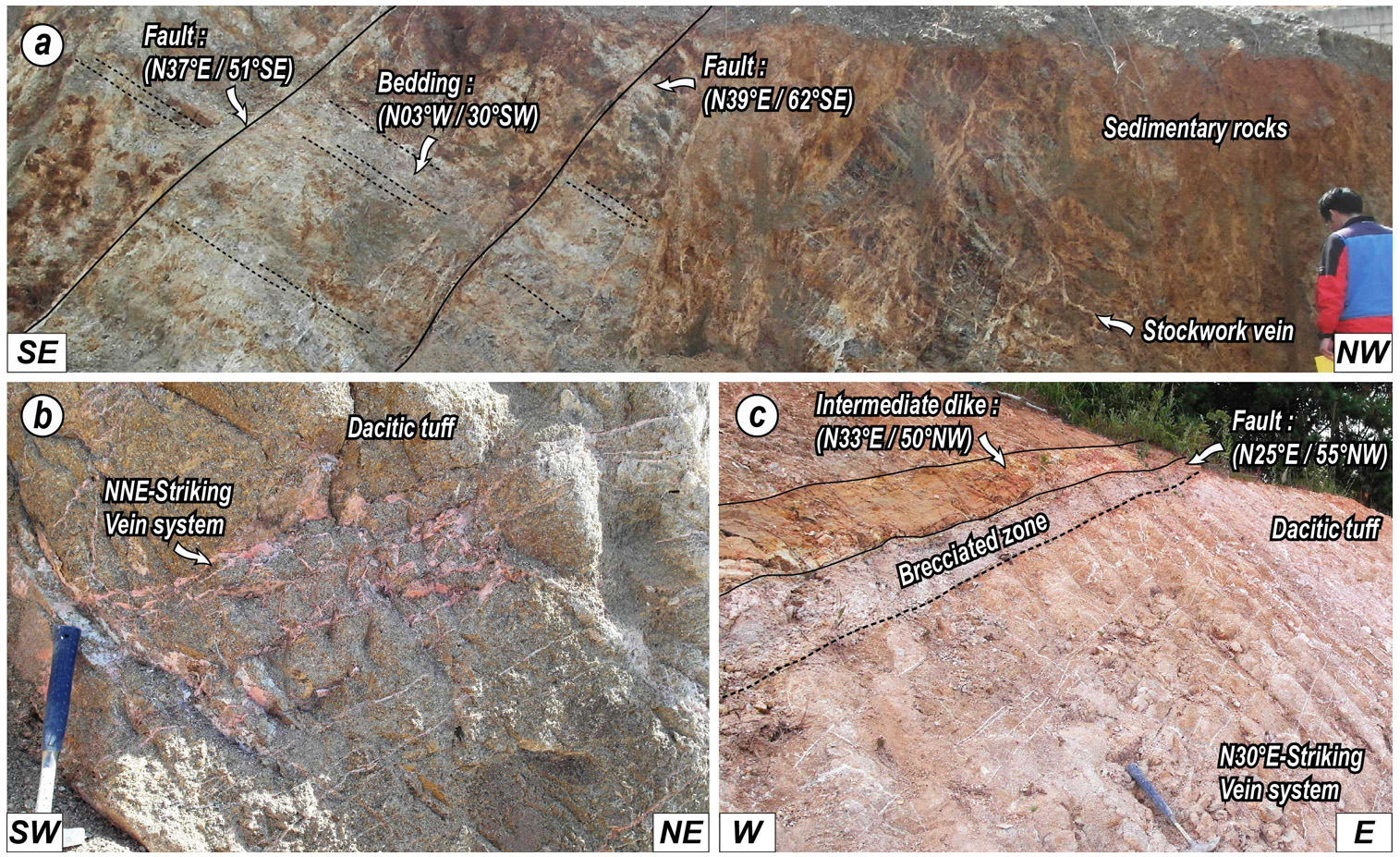
한반도 남동부 일광단층 일원 부차단층들의 기하학적 및 운동학적 특성
초록
양산단층계의 가장 동쪽에 위치하는 일광단층 일원의 상세 지표지질조사를 통해 다양한 규모로 나타나는 부차단층들의 분포, 기하 그리고 운동학적 특징과 단층비지의 자기미세구조 측정 결과를 종합하여 일광단층 일원의 지각 변형사를 해석하였다. 일광단층은 백악기 암석과 고신생기초 암맥들을 약 1.2 km의 우수향 수평변위로 절단한다. 일광단층 주변 부차단층들은 방향에 따라 남-북, 북북동 그리고 북동으로 구분된다. 이들의 단층핵은 1.5 m 이내의 폭을 가지며, 응집력이 없는 단층비지와 각력들로 구성된다. 단층손상대 내에는 단층과 유사한 방향의 광맥들이 망상으로 발달하고 있을 뿐만 아니라 심하게 풍화·변질되어 있어 연구지역이 단층활동 당시 또는 이후 상당한 열수작용을 겪은 것으로 판단된다. 단층 또는 전단단열의 기하와 운동감각 그리고 이들의 선후관계는 연구지역 내의 북북동 방향 단층들이 백악기말~고신생기초의 북서-남동 압축 환경 하에서 좌수향 주향이동운동을 겪었으며, 이후 빨라도 50 Ma 이후에 북동-남서 압축 환경 하에서 우수향 주향이동운동을 겪었음을 지시한다. 북동 방향 단층들의 단층비지에 대한 자기미세구조 측정 결과는 야외의 운동감각 지시자와 부합되며, 유사한 주향임에도 불구하고 단층에 따라 우수향과 좌수향 주향이동의 서로 다른 운동감각을 보여준다. 이러한 연구결과는 북동 방향 단층들이 R- 또는 P-전단으로 생성되어 지구조 환경의 변화에 따라 선택적으로 재활되었음을 시사한다. 이러한 일광단층 일원의 단층 운동사는 양산단층의 운동사와 전반적으로 잘 부합된다.
Abstract
In order to interpret the crustal deformation history in the vicinity of the Ilgwang Fault, which is the easternmost fault of the Yangsan Fault System, the distribution, geometries, and kinematic data of its various-scale subsidiary faults and the magnetic fabrics of fault gouges were synthetically analyzed. The Ilgwang Fault shows about 1.2 km of dextral strike-slip offset based on the distribution of the Cretaceous rocks and early Paleogene dikes. The subsidiary faults are divided into N-S-, NNE-, and NE-striking faults, and their cores, which consist of incohesive breccias and gouges, are generally within 1.5 m in width. Their damage zones within tens of meters in width are characterized with the pervasive invasion of veins that are sub-parallel to the faults, indicating vigorous hydrothermal activities during and/or after the faulting. Paleo-stress fields calculated from the geometries, kinematics, and relative chronologies of the minor faults and shear fractures are classified into ① late Cretaceous ~ early Paleogene NW-SE compression and ② NE-SW compression since at earliest 50 Ma, which resulted in the NNE-striking sinistral and dextral strike-slip faultings in the study area, respectively. Meanwhile, fault movement senses determined from magnetic fabrics of the NE-striking fault gouges, which are in concord with the slip senses observed in field, show that despite the similarity in strike the senses vary from fault to fault as dextral and sinistral strike-slips. This result indicates that the subsidiary faults, which initially formed as R- or P-shears of the Ilgwang Fault, were reactivated through a selective reactivation during the changes of regional stress regime. The crustal deformation history in the vicinity of the Ilgwang Fault is well-concordant with the previously reported movement history of the Yangsan Fault.
Keywords:
Ilgwang Fault, Subsidiary Fault, Selective Reactivation, NW-SE compression, NE-SW compression키워드:
일광단층, 부차단층, 선택적 재활, 북서-남동 압축응력, 북동-남서 압축응력1. 서 언
지각변형의 대표 결과물인 단층은 여러 판구조환경에서 다양한 운동감각을 보여주며, 지각의 융기와 침강을 수반한다(e.g., Sylvester, 1988; Davis and Reynolds, 1996; Townend and Zoback, 2000; Cunningham and Mann, 2007; Twiss and Moores, 2007). 또한 단층은 지구조환경 변화에 따라 다른 운동감각으로 쉽게 재활될 수 있으며, 지각강도, 유체흐름, 지진발생 등을 제어하기 때문에 지난 수 세기 동안 지질학자들의 주요연구대상이었다(e.g., Sylvester, 1988; Caine et al, 1996; Davis and Reynolds, 1996; Cunningham and Mann, 2007; Twiss and Moores, 2007; Fossen, 2010).
단층에 대한 종합적인 이해를 위해서는 자연 상태에서 실제 확인되는 단층대의 기재가 선행되어야 한다. 일반적인 단층대는 변위가 집중되어 모암의 형태가 대부분 지워진 단층핵(fault core)과 단층핵 주변으로 단열, 광맥, 습곡 등의 이차적인 변형이 수반되지만 모암의 형태는 보존된 단층손상대(fault damage zone)로 구분된다(e.g., Chester et al., 1993; Caine et al., 1996; Kim et al., 2004b). 하지만 대규모 단층의 경우에는 도심화 또는 충적물에 의해 단층핵이 피복되거나 노출 이후 풍화·변질로 내부구조를 파악할 수 있는 노두의 확인이 쉽지 않다. 이러한 경우 단층의 운동을 해석하기 위해 단층손상대 내에 형성된 이차적인 구조(부차단층, 전단단열, 광맥, 습곡 등)에 대한 접근이 필수적이다(e.g., Wilcox, 1973; Sylvester, 1988).
양산단층계는 한반도 남동부에 발달하는 북북동 방향의 대규모 주향이동 단층계로써 백악기~고신생기 퇴적암, 화산암 그리고 심성암을 우수향으로 절단할 뿐만 아니라, 일부 분절들은 제4기층을 절단하고 있다. 기존 연구들은 양산단층이 유라시아판 아래로 섭입하는 (고)태평양판의 운동방향의 변화에 따라 여러 번 운동감각을 달리하여 재활하였음을 보고하였다(Chang et al., 1990; Kim, 1992; Chang and Chang, 1998; Chang, 2002; Hwang et al., 2004; Cho et al., 2007; Choi et al., 2009; Kang and Ryoo, 2009). 따라서 양산단층계에 대한 연구는 한반도 남동부에 형성된 백악기~신생대 퇴적분지의 형성과 발달뿐만 아니라 동아시아 지구조 환경을 규명하는데 중요한 역할을 하며, 대규모 단층의 재활과 수반된 지각의 변형 양상을 이해함에도 상당한 가치가 있다. 하지만 비교적 활발한 연구가 진행된 양산단층과는 달리 양산단층계를 구성하는 다른 단층들에 대한 연구는 불량한 노출상태 등으로 인해 미진한 상태이다.
이번 연구는 양산단층계 중 가장 동편에 위치한 일광단층 일원의 변형특성과 단층 운동사를 이해하는데 목적이 있다. 이를 위해 상세 지표지질조사를 통해 다양한 규모의 단층과 부수 단열들의 분포와 기하를 파악하고 운동학적 자료를 수집하여 고응력장을 해석하였으며, 주요 단층암의 대자율이방성 실험을 통해 단층의 운동감각을 분석하였다. 이들 자료를 바탕으로 일광단층 일원의 변형과 재활 특성 그리고 일광단층의 운동사에 대해 토의하였다.
2. 지질학적 배경
양산단층계는 서쪽에서부터 자인, 밀양, 모량, 양산, 동래 그리고 일광단층으로 구성되며, 위성사진과 음영기복도 상에서 나란히 발달하는 북북동 방향의 선상구조로 뚜렷이 나타난다(그림 1). 양산단층은 양산단층계의 구성단층들 중에서 가장 연장이 길고 단층대의 폭이 넓어, 다른 단층들에 비해 다양한 방면의 연구가 진행되어 왔다. 양산단층은 육상에서 200 km 이상 연장되며, 수 km 폭의 단층대와 20 km 이상의 우수향 수평변위가 확인된다. Chang and Chang (2009)은 주향의 변화, 단층의 종결유형, 단층대 폭의 변화, 단층암의 변형패턴 그리고 이차단열의 각도변화에 근거하여 양산단층을 5개 분절로 구분하였다. 양산단층 일원의 암석학, 구조지질학, 지구물리학적 연구들은 양산단층이 다중변형을 겪어 백악기부터 신생대 동안 다양한 감각을 가지고 운동하였음을 보고하였다(Chang et al., 1990; Kim, 1992; Chang and Chang, 1998; Chang, 2002; Hwang et al., 2004, 2007a, 2007b, 2008a, 2008b, 2012; Cho et al., 2007; Choi et al., 2009; Kang and Ryoo, 2009). 양산단층대의 동편과 서편에서 대비되는 암상의 분포에 근거하여 양산단층은 여러 번의 운동 중에서 우수향 주향이동이 가장 중요하며, 백악기 퇴적암의 대비를 통해 25 km (Reedman and Um, 1975; Choi et al., 1980; Um et al., 1983)와 35 km (Chang et al., 1990) 그리고 약 50 Ma의 A-type 화강암(남산화강암)의 대비에 근거하여 21.3 km의 우수향 주향이동 변위를 겪었음이 보고된 바 있다(Hwang et al., 2004, 2007, 2008a, 2008b).
일광단층은 동래·월내도폭(Son et al., 1978)에서 선상구조로 존재가 처음 추정되었으며, 1:250,000 부산도폭(Kim et al., 1998)에서는 일광단층이 하부의 이천리층은 절단하지만 백악기말의 안산암질 화산암류에 의해 피복되어 있음에 근거하여, 일광단층의 최후 운동이 백악기말 안산암질 화산암류의 분출 이전으로 해석하였다. 한편, Kim et al. (2003)은 전기비저항과 탄성파 탐사를 통해 일광단층대가 약 150~180 m의 폭을 가지며, 트렌치 조사에 근거하여 단층핵이 단층비지, 단층각력 그리고 단층파쇄암으로 구성됨을 보고하였다. Lee and Yang (2005)은 일광단층의 주 단층(main fault)과 부차단층(subsidiary fault)들의 단층점토를 이용한 ESR 연대측정 결과를 토대로 100~130만년과 50~60만 년 전에 일부 분절이 재활되었으며, 단층활동이 50~60만년의 주기를 가지고 제4기에도 지속되었음을 제안하였다. 최근 Kim et al. (2015)의 해상 지진파 탐사 연구는 일광단층의 연장과 아평행한 부차단층들의 존재를 보고하기도 하였다.
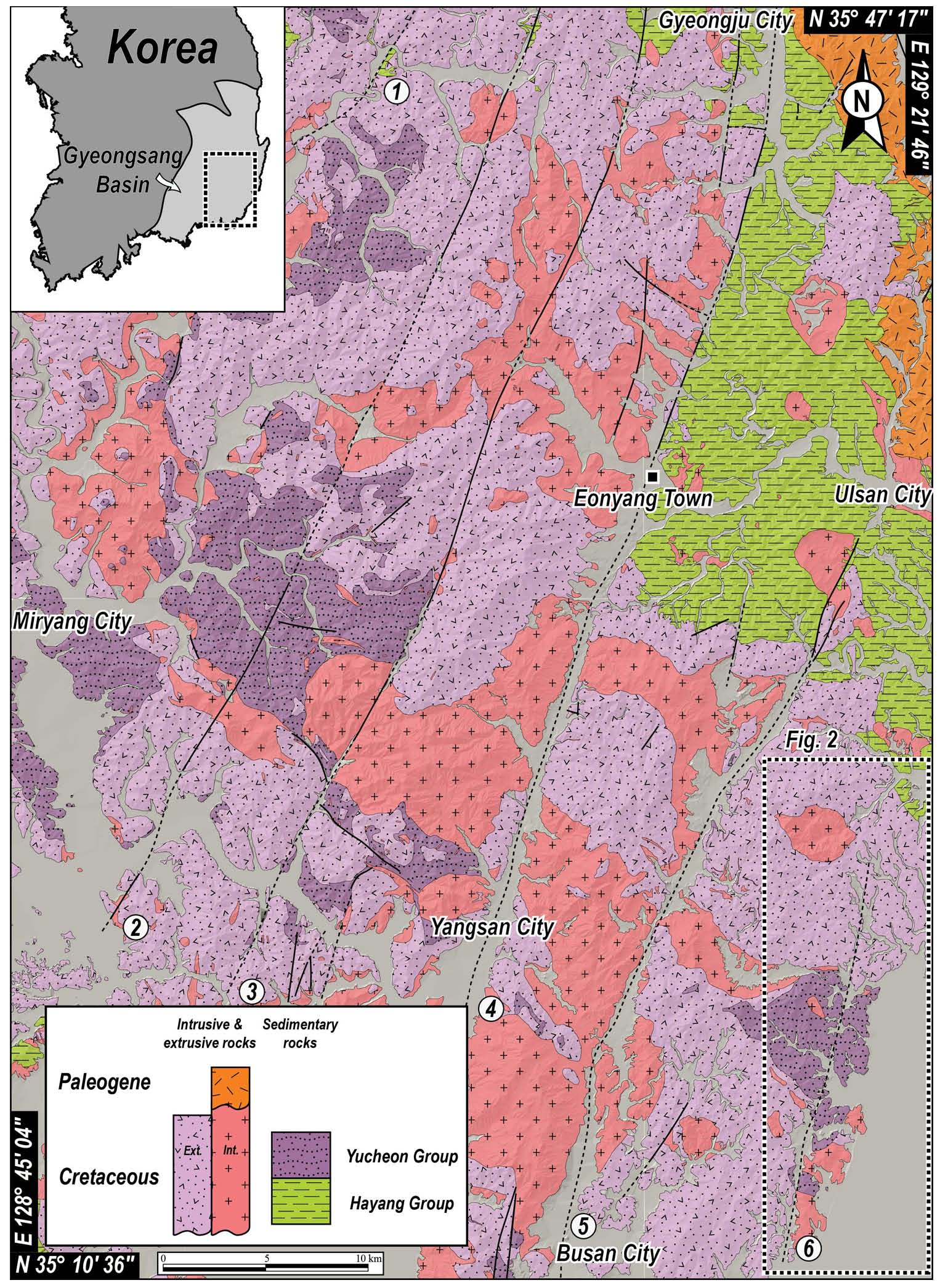
Geological map of the southeastern part of the Gyeongsang Basin showing the distribution of basin fills and Yangsan Fault System. ① Jain Fault, ② Miryang Fault, ③ Moryang Fault, ④ Yangsan Fault, ⑤ Dongnae Fault, ⑥ Ilgwang Fault (modified after Lee and Kang, 1964; Kim et al., 1971; Lee and Lee, 1972).
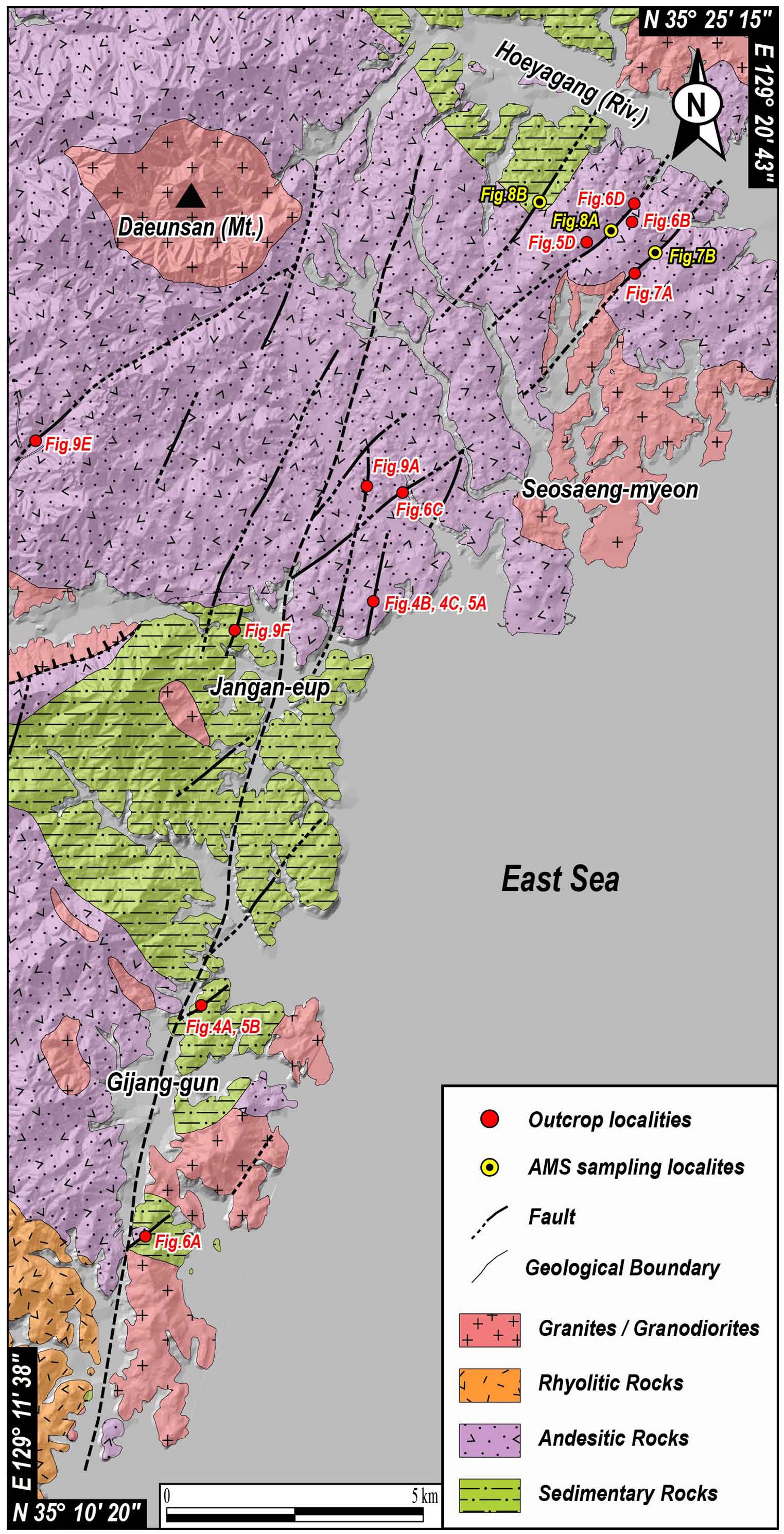
Detailed geological map of the study area showing distribution of the Ilgwang Fault and subsidiary faults (modified after Park and Yoon, 1968; Son et al., 1978).
연구지역은 백악기말 퇴적암과 화산암, 백악기 말~고신생기초의 화강암이 분포하고 있다. 가장 하부층인 백악기 퇴적암은 대부분 호온펠스화된 이암, 사암 그리고 역암으로 구성되며 연구지역 남부(부산시 기장군 일광면, 정관면)와 북부(울산시 울주군)에 분포한다(그림 2). 남부의 백악기 퇴적암은 동래/월래도폭(Son et al., 1978)에서 이천리층으로, 북부의 퇴적암은 방어진도폭(Park and Yoon, 1968)에서 울산층으로 각각 명명되어 있다. 이들 퇴적암은 시대를 지시하는 화석이 산출되지 않아 정확한 지층대비가 쉽지 않지만, Chwae et al. (1988)는 울산층을 하양층군의 진동층에 대비한 반면, Kim et al. (1998)은 이천리층을 유천층군 다대포층과 대비하였다. 이천리층의 자세는 대체로 북동 주향에 북서 방향으로 경사져 있으며 평균 17°의 경사각을 가지지만, 부차 단층 주변에서 고각의 경사각과 교란된 주향이 인지된다. 백악기 퇴적암을 피복하거나 단층으로 접하는 유천층군 화산암류(Son et al., 1978)는 주로 안산암질 응회암이 우세하지만, 일부 데사이트질 응회암 또는 데사이트질~안산암질 관입/분출암이 확인된다. 화강암체는 퇴적암과 화산암체를 관입하고 있으며, 광물조성과 조직에 따라 화강섬록암과 화강암으로 구분된다. Kang (2014)은 두 화강암체가 68~65 Ma의 절대연령을 가지며, 화강섬록암, 각섬석화강암, 흑운모화강암 그리고 미문상화강암으로 세분됨을 보고하였다. 마지막으로 전술한 암석들을 관입한 다양한 조성의 암맥류들은 수 cm~수십 m의 폭을 가지며 연구지역 도처에 분포한다. 이들의 절대연령은 Ar-Ar 연대측정 결과, 44 Ma로 보고된 바 있으며(Korea Hydro & Nuclear Power Co. Ltd., 2002), 한반도 남동부에 발달하는 암맥군의 Ar-Ar 절대연령 연구결과들도 이들 암맥의 관입시기를 약 62~44 Ma로 해석하였다(Kim et al., 2005; Son et al., 2007).

(a) Contour π- and (b) rose diagrams for all the fault attitudes in the study area. Gray line (red line in color version) indicates the lineament direction of the Ilgwang Fault.
3. 일광단층 일원 단층들의 구조 특성
위성영상과 음영기복도 상에서 확인되는 일광단층의 선상구조는 부산시 해운대구 송정해수욕장에서부터 울산시 울주군 서생면까지 평균 N10°E의 방향으로 약 25 km의 연장을 가진다. 또한 절단된 백악기 퇴적암류와 화산암류에 근거하여 약 1.2 km의 우수향 수평변위를 가지는 것으로 알려져 있다(Kim et al., 2003). 주 단층대는 14번 국도와 거의 평행하게 달리지만, 도심화에 따른 불량한 노출 때문에 노두로 인지하기 힘든 상태이다. 하지만 연구지역 내에는 일광단층의 운동에 의해 수반된 다양한 규모의 부차단층들이 확인된다.
확인된 단층들은 방향에 따라 남-북, 북북동 그리고 북동 방향으로 구분가능하며(그림 3), 경사각은 대체로 60° 이상이지만 저각인 경우도 간혹 확인된다. 이들 단층대는 주로 응집력이 없는 단층점토와 단층각력으로 이루어진 1.5 m 내외 폭의 단층핵과 수십 m 폭을 가지는 단층손상대로 구성된다. 특징적으로 단층핵 내에는 광맥들이 망상(anastomosing)으로 분포하는 반면(그림 4a), 단층손상대 내에는 단층 방향과 거의 평행하게 나타나며(그림 4b, 4c), 전반적으로 심한 풍화·변질을 수반한다. 이는 연구지역이 단층활동 당시 또는 이후에 상당한 열수작용을 겪었음을 지시한다. 야외조사를 통해 확인된 주요 단층노두들의 구조적 특징을 단층 방향별로 구분하여 기술하면 다음과 같다.
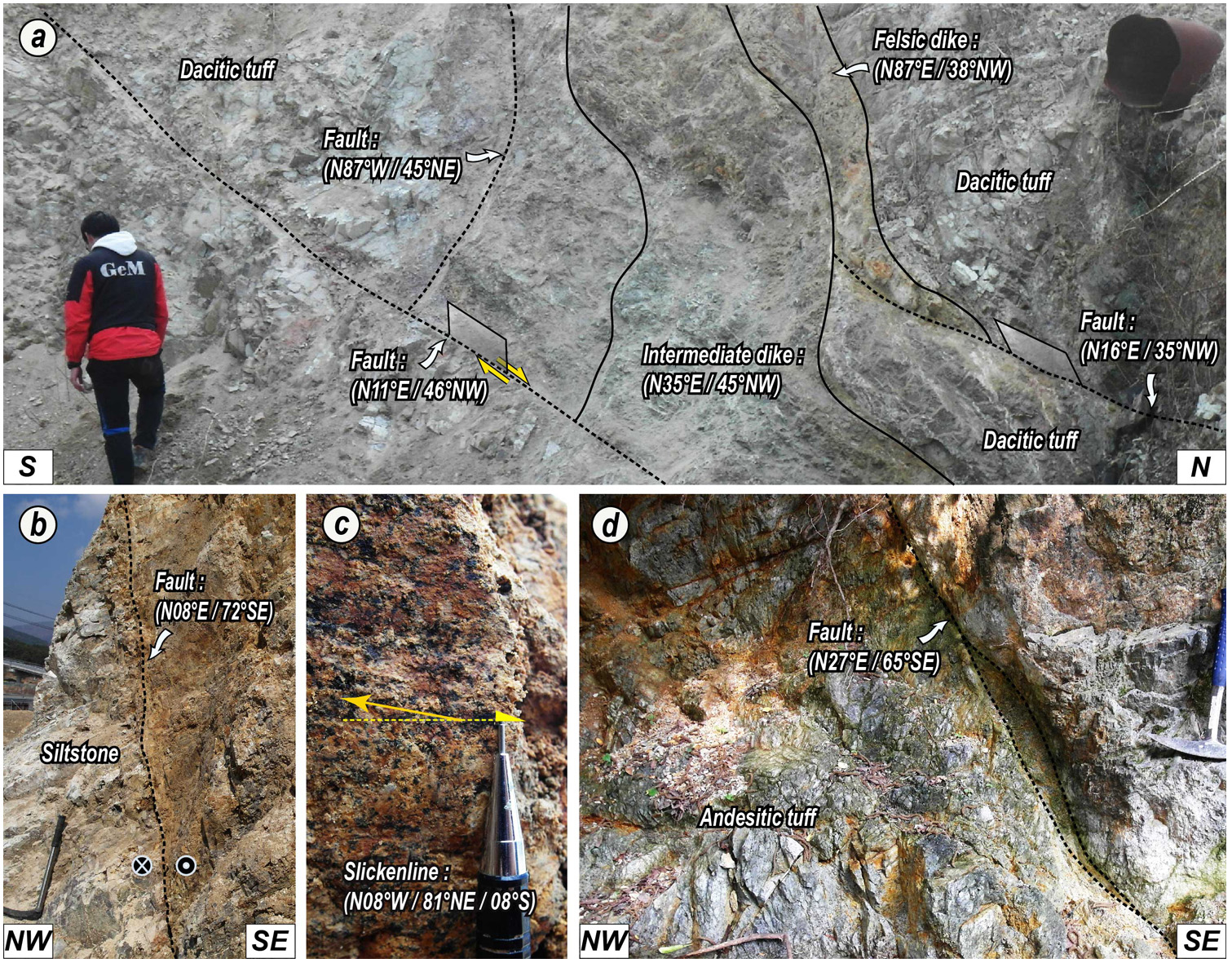
Outcrop photographs showing major features of NNE-striking faults. (a) An exposure showing cross-cutting relationship between dikes and faults. Note that all dikes and faults are offset by a NNE-striking dextral fault. (b) A NNE-striking fault cutting siltstone and (c) its dextral strike-slip sense with small reverse component on the fault surface. (d) Andesitic tuff offset by a NNE-striking fault.
3.1 북북동 방향 단층의 야외기재학적 특성
부산광역시 기장군 장안산업단지 건설현장 내에서 발견한 노두(그림 5a; 35°19'29.8”N, 129°15'48.20”E)에서는 데사이트질 응회암을 관입한 암맥들과 단층들의 선후관계가 확인된다. 데사이트질 응회암과 규장질 암맥(N87°E/38°NW)은 N16°E/35°NW 자세를 가진 단층에 의해 절단되며, 이들을 N35°E/45°NW 자세의 중성질 암맥이 관입하고 있다. 마지막으로 N11°E/46°NW 자세의 단층이 모든 구조들을 우수향으로 절단하고 있다. 이 노두에서 확인되는 단층들은 1 cm 이내의 단층비지를 가지며 단층각력은 전혀 확인되지 않는다. 또한 노두 전반에 걸쳐 북북동 내지 북동 방향의 광맥들이 망상으로 발달하며, 최근에 노출된 사면임에도 불구하고 심한 풍화·변질이 인지된다.
부산기장경찰서 북쪽 사면에서 발견한 단층(그림 5b; 35°15'25.6”N, 129°13'31.1”E)은 N08°E/72°SE의 자세로 미사암을 절단하고 있으며, 단층핵은 약 1 cm 미만의 폭을 가지며 단층비지로 구성되어 있다. 단층활면에서 확인되는 단층조선들은 미세한 역이동성 감각을 포함한 우수향 주향이동 운동감각을 지시하며(그림 5c), 노두 전반에 걸쳐 발달하는 북북동~북동 방향의 전단단열 또한 우수향 주향이동운동을 뚜렷이 지시한다. 울산광역시 울주군 서생면 화정리 부근에서 발견한 단층(그림 5d; 35°23'15.37”N, 129°18'42.58”E)은 N27°E/65°SE의 자세로 안산암질 응회암을 절단하고 있다. 단층핵은 약 1.5 cm의 두께를 가지며 단층비지 내지 단층각력으로 구성되어 있으며, 운동감각을 지시할만한 증거는 확인되지 않는다.

Outcrop photographs showing major features of NE-striking faults. (a) A NE-striking dextral strike-slip fault between vertically tilted sedimentary rock and andesitic rock. (b) A NE-striking fault inferred as sinistral strike-slip fault, based on the slip senses of nearby shear fractures. (c) A NE-striking fault showing about 20 cm-thick core consisting of fault breccias of ~7 cm in diameter. (d) Andesitic tuff offset by a NE-striking fault that shows a fault breccia zone from 5 to 20 cm in width.
3.2 북동 방향 단층의 야외기재학적 특성
부산시 기장군 연화터널 인근 노두(그림 6a; 35°13'12.47”N, 129°12'48.16”E)에서 확인된 단층은 N45°E/70°SE의 자세로, 약 1 cm 두께의 단층점토로 구성된 단층핵이 동편의 퇴적암과 서편의 안산암류의 경계를 이루고 있다. 단층활면에서 확인되는 단층조선은 미세한 역이동 감각을 포함한 우수향 주향이동운동감각을 지시한다. 북서 방향으로 20~30° 내외로 경사진 연구지역의 일반적인 지층 자세와 달리, 이곳 단층 인접부의 퇴적층의 자세는 단층의 영향으로 수직에 가깝게 경동된 특징을 보인다. 울산시 울주군 서생면 화정리 인근 단층(그림 6b; 35°23'15.37”N, 129°18'42.58”E)은 N41°E/61°SE의 자세로 안산암질 응회암을 절단하고 있다. 단층핵은 1 cm 미만의 단층점토와 응집력이 없는 단층각력으로 구성된다. 주단층면에서 운동감각을 지시하는 증거는 확인되지 않으나, 주변 전단단열들에서는 좌수향 주향이동 운동감각이 확인된다. 한편, 부산시 기장군 장안읍 길천리 부근 단층(그림 6c; 35°20'24.23”N, 129°16'21.13”E)은 N35°E/65°NW의 자세로 안산암질 응회암을 절단하고 있다. 약 20 cm 폭의 단층핵은 최대 직경 7 cm이상의 단층각력들로 구성되며 단층점토는 관찰되지 않는다. 울산시 울주군 서생면 화정리 부근에서 확인한 단층(그림 6d; 35°23'18.41”N, 129°18'47.53”E) 역시 N38°E/68°NW의 유사한 자세를 가지며 안산암질 응회암을 절단하고 있다. 단층각력으로 구성된 단층핵은 최소 5 cm에서 최대 20 cm의 폭을 보여준다. 이들 두 단층 또한 주 단층면에서 운동감각을 지시하는 증거가 확인되지 않으나, 단층과 유사한 방향을 가지는 전단단열들의 단층조선들이 좌수향 주향이동을 지시하고 있다.
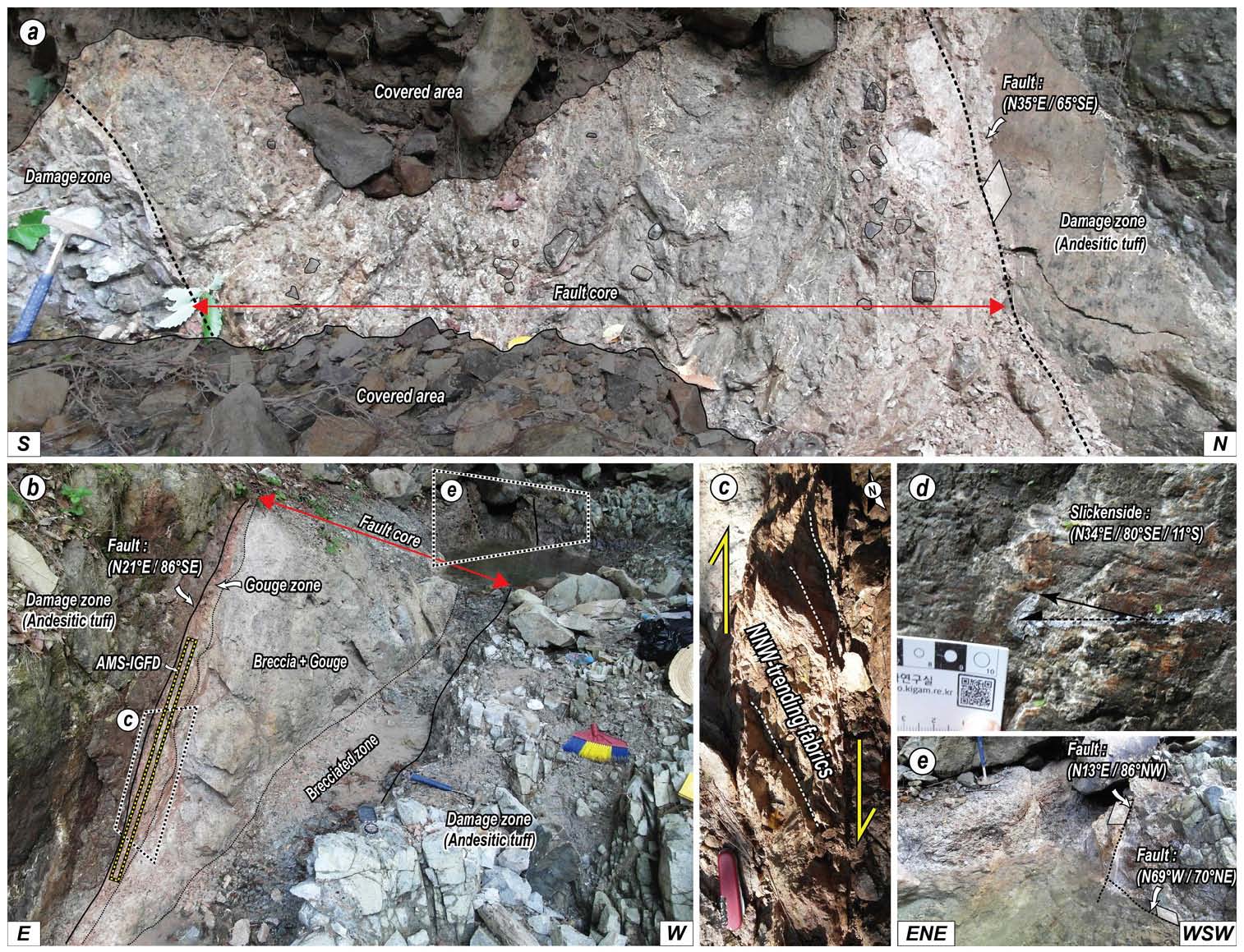
Outcrop photographs showing major features of NE-striking faults in the northeastern part of the study area. (a) A NE-striking dextral strike-slip fault showing 1.2 m-width fault core consisting of breccias. The fault core is bounded by thin gouge zones on both sides. (b) An northeastward extension of the NE-striking fault in (a), in which its fault core consists of gouge and breccia. (c) S-C fabric within the fault core and (d) slickenlines on the fault surface indicating a dextral strike-slip movement. (e) A WNW-striking fault transected by a NNE-striking fault.
한편 연구지역 북동부 회야강 남쪽에는 상대적으로 규모가 큰 북동 방향 단층들이 관찰된다. 울주군 서생면 화정리 인근에서 확인된 단층(그림 7a; 35°22'47.44”N, 129°19'02.74”E)은 N35°E/65°SE의 자세로 안산암질 응회암을 절단한다. 1.2 m 폭의 단층핵은 직경 10 cm 이내의 단층각력들로 주로 구성되며, 단층핵의 양 끝단에서는 2 cm 내외 두께의 단층비지가 관찰된다. 또한 단층핵 내에는 광맥들이 망상으로 발달하며, 광맥 표면에 우수향 주향이동감각을 지시하는 단층조선이 다수 관찰되고 있어 광맥을 형성시킨 열수작용 이후에도 광맥을 따라 전단작용이 발생하였음을 지시한다. 이 단층의 북동쪽 연장선에 위치한 노두(그림 7b; 35°22'48.47”N, 129°19'03.24”E)에서는 N21°E/86°SE의 자세로 안산암질 응회암을 절단하는 단층이 확인된다. 1 m 폭의 단층핵은 최대 7 cm 정도의 폭을 가지는 단층비지대, 점토화된 기질과 직경 1 cm의 각력들이 혼재된 부분 그리고 단층각력들로만 구성된 부분으로 구분된다. 단층핵 내에서 인지되는 S-C 조직(그림 7c)과 단층활면에서 확인되는 단층조선(그림 7d)은 이 단층이 역이동성 감각이 미약하게 포함된 우수향 주향이동감각으로 운동하면서 서북서 방향의 단층을 절단하였음을 알려준다(그림 7e).
울주군 서생면 화정리 술마마을 인근에서 확인된 북동 방향 단층(그림 8a; 35°23'14.34”N, 129°18'42.42”E) 또한 안산암질 응회암을 절단하고 있다. 30 cm 폭의 단층핵은 단층각력대와 약 2 cm 두께의 단층비지 두 매로 구분된다. 우측의 단층비지에서 발견된 단층조선은 N06°E/51°SE/13°S로 좌수향 횡압축성 운동감각을 지시하고 있다. 두 비지대의 자세는 각각 N53°E/45°NW와 N11°E/62°NW로 서로 약간의 차이를 보여주며, 북서쪽 인접부에도 두 매의 소규모 북동 방향 단층이 확인된다. 이곳 단층들이 상부의 제4기층을 절단하거나 변형시킨 흔적은 발견되지 않는다. 한편, 울주군 서생면 발리 인근 단층(그림 8b; 35°23'29.69”N, 129°17'45.96”E)은 N45°E/68°SE의 자세를 가지며 이암을 절단하고 있다. 단층핵은 10 cm 내외의 두께를 가지며, 단층비지와 변질대로 구성된다. 주변의 지층들은 수직에 가깝게 경동되어 있으며, 단층 인접부에는 북동 방향의 축을 가지는 개방습곡이 관찰되기도 한다(그림 8c). 이 노두에서는 좌수향 주향이동을 지시하는 단층조선이 우세하게 관찰된다.
일광단층의 북동부 말단으로 판단되는 연구지역 북동부에 특징적으로 관찰되는 세 매의 북동 방향 단층의 정확한 운동감각을 결정하기 위해 대자율이방성을 이용하여 단층비지의 미세구조를 파악하고자 하였으며, 그 결과는 3.4절에 소개하도록 하겠다.
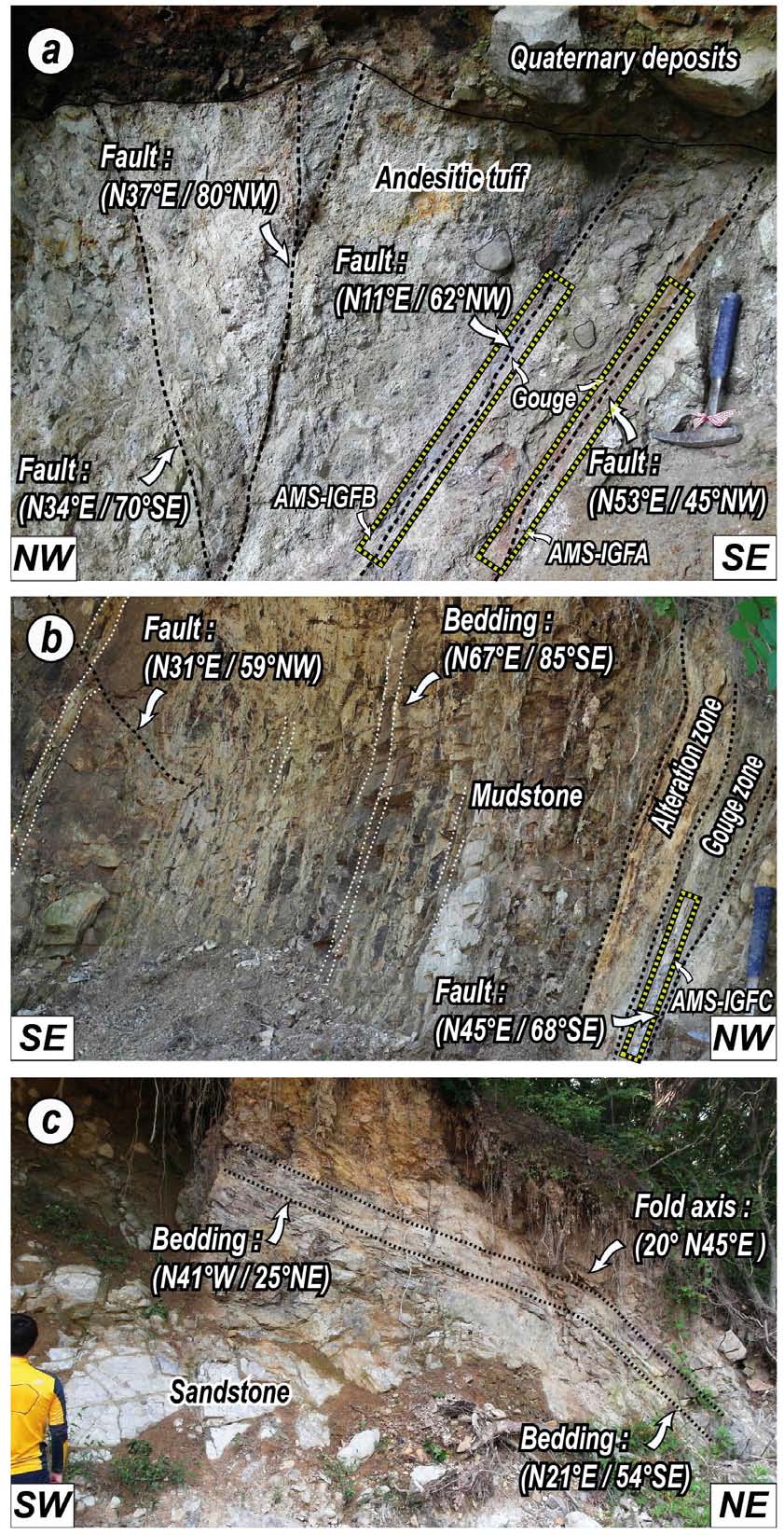
Outcrop photographs showing major features of NE-striking faults in the northeastern part of the study area. (a) A NE-striking sinistral strike-slip fault with 30 cm-wide fault core composed of two thin fault gouge layers and breccias. (b) Vertically tilted mudstones observed along a NE-striking sinistral strike-slip fault. (c) An open fold with NE-trending axis adjacent to the NE-striking fault in (b).
3.3 남-북 방향 단층의 야외기재학적 특성
부산시 기장군 장안읍 반룡마을 입구의 노두(그림 9a; 35°20'28.07”N, 129°15'35.10”E)에서는 남-북방향의 단층이 약 50 m 이상 연장되어 절개사면에 노출되며 단면과 평면에서 단층의 기하를 관찰할 수 있다. 응집력이 없는 단층각력으로 구성된 단층핵은 최대 50 cm 폭을 가지며 북쪽에서 남쪽으로 갈수록 폭이 좁아지는 경향을 보여준다(그림 9b, 9c, 9d). 단층대 주변의 남-북~북북동 방향의 전단단열의 단층조선들은 우수향 주향이동운동을 지시한다. 기장군 정관읍 병산마을 근처에서 발견한 단층(그림 9e; 35°21'03.72”N, 129°11'34.06”E)은 N03°E/25°SE의 자세로 안산암질 응회암을 절단하고 있다. 단층핵은 1~2 cm의 단층점토로 이루어져 있으며, 북서 방향의 단층을 가로지르며 발달한다. 또한 기장군 장안읍 프리미엄아울렛 주차장에서 확인된 단층(그림 9f; 35°19'26.98”N, 129°13'47.76”E)은 N04°W/82°NE의 주향을 가지며 퇴적암을 절단하고 있다. 20 cm 내외의 두께를 가지는 단층핵은 3 cm 정도의 변질된 단층점토대와 단층각력으로 구성된다.
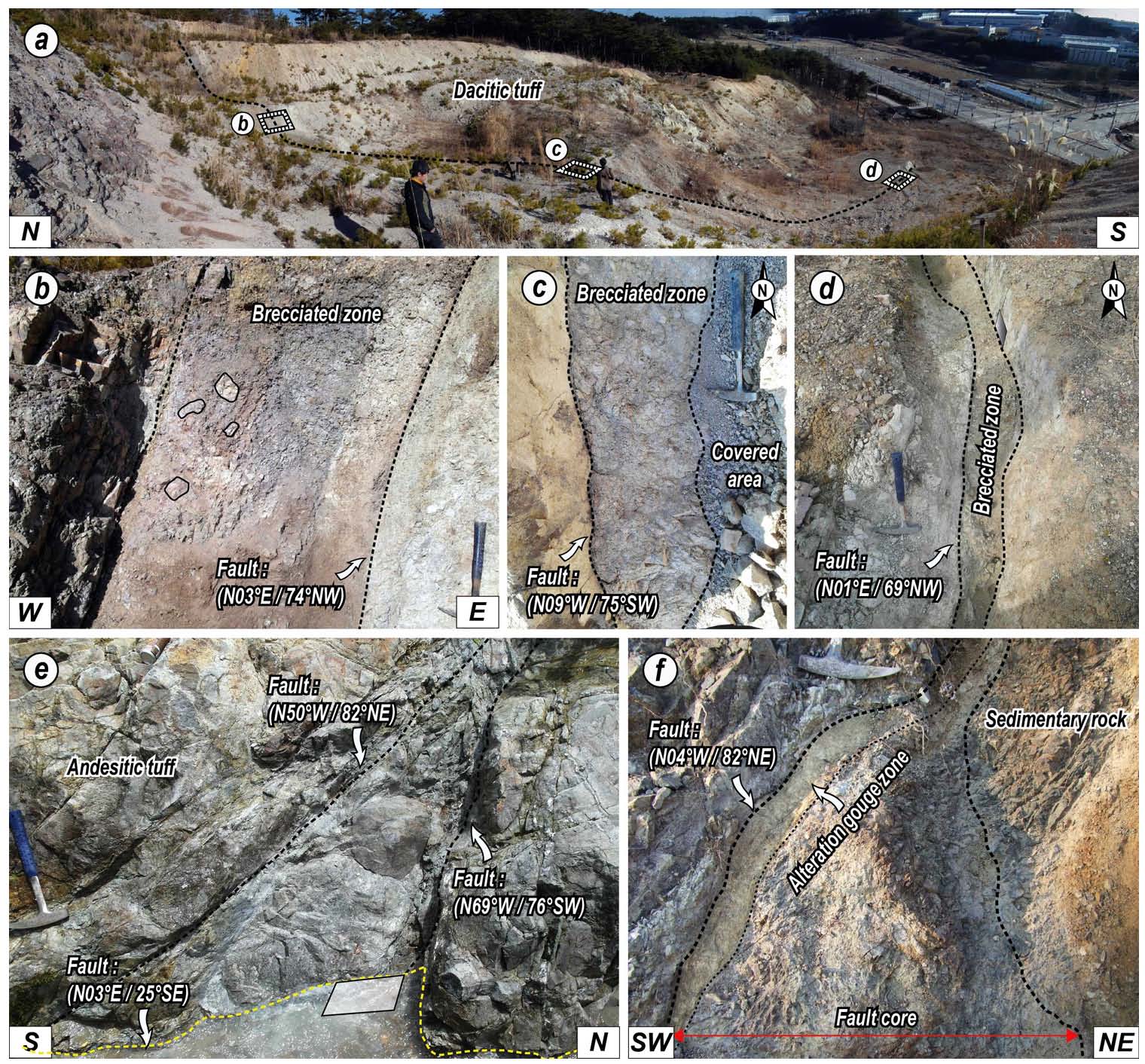
Outcrop photographs showing major features of N-S-striking faults. (a) An exposure showing about 50 m-extension of N-S-striking fault and (b~d) its fault core composed of breccias, which becomes narrow toward the south. (e) Two WNW-faults offset by a low-angle N-S-striking fault. (f) A N-S-striking fault with ~20 cm-thick fault core consisting of gouge and breccias.
3.4 북동 방향 단층암의 대자율이방성 특성
단층의 운동감각은 단층면에서 확인되는 단층조선, 수다자국(chatter mark), 결정섬유(crystal fiber), 단층홈(ridge and groove) 등이나 단층대 내의 끌림습곡(drag fold)을 이용하여 결정할 수 있다. 이와 함께 단층암 특히, 단층비지 내부는 전단작용에 의해 구성입자들이 특정 방향으로 배향(preferred orientation)되는데, 이러한 입자 배열은 야외에서 육안으로 확인되는 경우도 있지만 대부분 이차원적 해석만 가능하며, 얇은 두께의 단층비지의 경우에는 현미경 관찰이나 슬랩 분석을 통해야만 한다. 한편, 최근 들어서는 단층암의 자기미세구조를 이용하여 단층의 3차원 운동학적 특성을 빠르고 간편하게 측정하고 효과적으로 표현하는 연구들이 활발하게 진행되고 있다(Astudillo et al., 2008; Solum and van der Pluijm, 2009; Cho et al., 2014).
이번 연구에서는 연구지역 북동부의 북동 방향 단층대 내 단층비지의 대자율이방성(Anisotropy Magnetic Susceptibility, AMS)을 이용하여 전단작용에 의한 입자 배열을 밝히고(Hrouda, 1982; Rochette et al., 1992; Cho et al., 2014) 이를 야외에서 확인되는 전단감각과 비교하여 단층의 최후 운동감각을 해석하고자 하였다. 단층비지 시료는 총 3개 노두의 4개 지점에서 직경 2 cm의 정육면체 박스를 이용하여 채취하였다(그림 3, 7b, 8a, 8b). 대자율이방성 실험은 부산대학교 공동실습관의 AGICO 사 Kappabridge KLY-4S를 사용하였다. 단층비지의 자기미세구조는 일반적으로 최후기 전단변형으로 만들어진 미세구조에 대응되며, 대자율이방성 타원체의 세 주축(k1, k2, k3)은 변형타원체 세 주축(s1, s2, s3)에 각각 대응된다. 측정된 주축은 등적투영망에 도시하여 자기미세구조를 파악할 수 있다.
대자율이방성의 분석 결과는 표 1과 그림 10에 요약하였다. 우선 한 노두(그림 8a)에서 채집된 IGFA (N53°E/45°NW)와 IGFB (N11°E/62°NW)의 결과를 살펴보면, IGFA는 k1과 k2이 단층면과 거의 평행한 북동 방향의 대원 분포를 보인다. k3는 단층면을 수직으로 보정하였을 때 북서 방향으로 평균 11°로 경사지며 단층의 상반에 군집을 이룬다(그림 10a). 이와 같이, 수직 보정 시 k3가 상반에 놓이며 k1과 k2가 대원을 이루는 특징은 단층이 순수한 역이동성 운동을 하였음을 지시한다(Fossen, 2010; Cho et al., 2014). 반면, IGFB는 각 세 축의 군집도가 높으며 단층면을 수직으로 보정한 이후에 k1은 저각으로 남남서 방향으로 군집되고 k3는 저각으로 서북서 방향으로 군집되고 있어(그림 10b), 단층이 좌수향 주향이동 운동을 하였음을 지시한다(Cho et al., 2014). 이러한 결과는 IGFB를 포함한 이곳 노두의 전단면들에서 좌수향 주향이동 운동감각의 단층조선이 우세하게 관찰된다는 점과 부합된다. 30 cm 간격을 두고 유사한 두께를 가지는 두 단층비지대에서 확인되는 이러한 미세구조 배열의 차이는 서로 다른 응력장이 원인이기 보다는 주응력의 방향과 전단면의 자세와 밀접하게 관련될 것으로 판단된다. 즉, IGFB의 경우 전단면의 주향(N11°E)과 최대수평응력(북서-남동) 사이의 각도가 상대적으로 작고 전단면의 경사가 고각(62°NW)이기 때문에 좌수향 주향이동 운동이 우세한 반면, IGFA의 경우 전단면의 주향(N53°E)과 최대수평응력(북서-남동)사이 각이 거의 수직이며 전단면의 경사가 상대적으로 저각(45°NW)이기 때문에 역이동성 운동이 발생했던 것으로 해석된다.
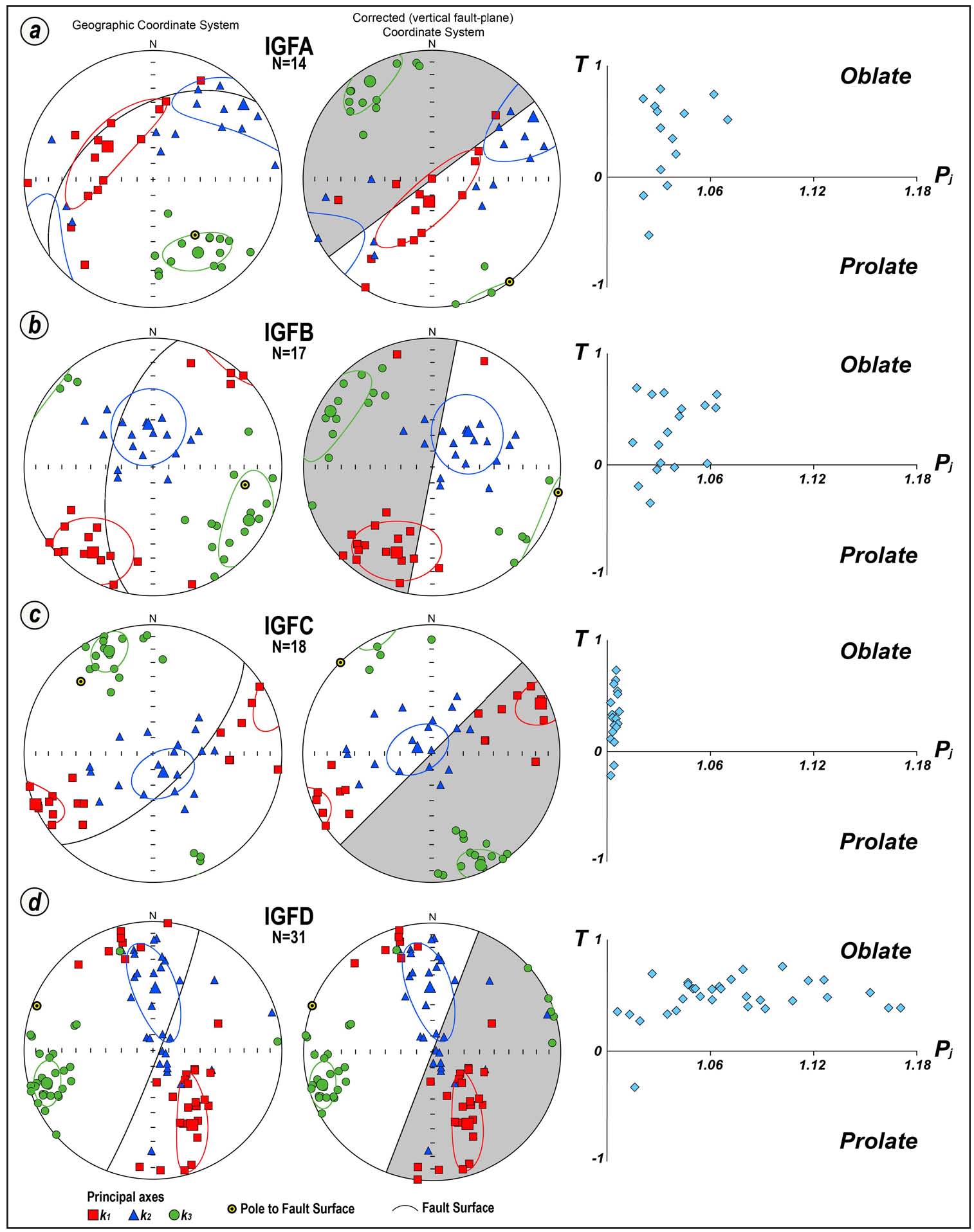
AMS results from the fault gouge of NE-striking faults in the northeastern part of the study area. Left: equal-area lower hemisphere projections showing the AMS principal axes (k1, k2 and k3), their 95% confidence ellipses, and fault attitudes. Center: equal-area projections in which fault surfaces are corrected to be vertical for convenience of interpretation (Gray color area represents hanging wall). Right: Pj-T diagrams showing corrected anisotropy degree (PJ) and shape (T) of AMS ellipsoids.
한편, IGFC (그림 8b; N45°E/68°SE)는 단층면을 수직으로 보정한 후, k1이 동북동 방향으로 거의 수평으로 군집되고 k2가 거의 수직으로 분포하며, k3는 북북서 방향으로 거의 수평으로 군집되어 나타난다(그림 10c). 이는 단층의 좌수향 주향이동 운동을 지시하는 것으로 이곳 노두에서 관찰된 운동감각뿐만 아니라 북동 방향의 개방습곡 축 방향과도 비교적 잘 부합된다. IGFD (그림 7b; N21°E/86°SE)는 k1과 k2가 북북서 방향의 대원을 형성하고 k3는 동북동 방향으로 저각도로 군집된다(그림 10d). k1과 k2가 이루는 북북서 방향의 대원 분포 즉, 자기적 엽리구조는 야외에서 관찰된 S-C 조직의 S면 방향과 평행하며(그림 7c) 이 단층이 우수향 주향이동 운동을 하였음을 지시한다. 이상의 IGFC와 IGFD 단층비지의 자기미세구조와 야외에서 관찰된 운동감각은 연구지역이 시대를 달리하는 다른 응력장 하에서 다중변형, 즉 북북동 내지 북동 방향의 단층들이 좌수향과 우수향의 최소 2회 이상의 운동을 겪었으며, 단층들이 각기 다른 선택적 재활(selective reactivation)을 겪었음을 암시한다. 단층의 선택적 재활에 관한 논의는 4.3절에서 보다 자세히 하도록 하겠다.
3.5 고응력장 복원
일광단층을 포함한 주변 단층들의 운동을 발생시킨 고응력장 복원을 위해 소규모 단층 또는 전단단열의 기하와 운동학적 자료가 수집되었다. 총 116개의 운동 자료들을 단층지구조분석법(Choi, 1995)으로 분석하여 크게 두 번의 변형(Dn, Dn+1)을 구분하였으며(그림 11), 야외에서 확인된 단층조선의 선후관계를 이용하여 상대적인 순서를 결정하였다. 먼저 Dn은 북서-남동의 최대수평주응력(σHmax)과 함께 북동-남서의 최소수평주응력(σHmin)이 도출되었으며 (R′=0.523~1.376; Delvaux et al., 1997), 이는 일광단층을 포함하는 북북동 방향 단층들의 좌수향 주향이동과 관련될 것으로 판단된다. 한편, Dn+1은 북동-남서의 최대수평주응력과 북서-남동의 최소수평주응력이 도출되었는데, 이는 이들 단층의 우수향 주향이동과 밀접히 관련될 것으로 해석된다(R′=1.409~2.179). 두 변형의 선후관계는 야외에서 확인된 여러 노두에서 Dn을 지시하는 단층조선이 Dn+1을 지시하는 단층조선에 의해 지워지는 양상(over printing)이 빈번하게 확인되고 있어, Dn이 주도한 좌수향 주향이동운동이 우수향 주향이동에 비해 먼저임을 알려준다. 한편, 연구지역에는 동-서 방향의 최소수평주응력을 지시하는 운동감각도 인지되었으나, 선후관계에 대한 증거는 불충분하다. 이상과 같이 복원된 고응력장은 일광단층 일원이 북서-남동 방향의 압축 이후 북동-남서 방향의 압축력 하에 있었으며, 응력환경의 변화에 따라 최소 2회 이상의 다른 변형을 겪었음을 지시한다.
4. 토 의
4.1 부차단층들의 특징과 의미
양산단층계를 구성하는 주요 단층들(자인, 밀양, 모량, 양산, 동래, 일광단층)은 지질도 상에서 대부분 하나의 선으로 표현되어 왔다. 그러나 이들 주 단층들 사이에도 이와 평행 또는 아평행한 비교적 규모가 큰 여러 부차단층들이 존재할 것으로 예상되며, 실제로 양산단층과 동래단층 사이에서 수 m 폭의 손상대를 가지며 십여 km 이상 연장되는 북북동 방향의 법기단층이 보고된 바 있다(Son et al., 2003). 이번 연구에서 비록 일광단층의 단층핵을 보여주는 노두는 발견되지 못했지만, 주변에 다양한 규모의 단층들이 최소 수십 매 분포하고 있음이 확인되었다. 대규모 단층들은 단층선을 따라 넓은 곡부가 발달하고 도심화로 인해 주 단층손상대를 직접 관찰하기 쉽지 않으므로, 이번 연구와 같이 다양한 규모의 주변 부차단층들의 분포, 기하 그리고 운동학적 특성을 연구함으로써 인근 주 단층대의 변형과 진화사를 간접적으로 해석할 수 있을 것으로 판단된다.
일광단층과 평행 또는 아평행한 부차단층들은 대부분 60° 이상의 고경사를 가지며 1~2 m 내외의 단층핵 그리고 수십 m 이내의 단층손상대를 보여준다. 단층 인접부에는 끌림작용으로 고각으로 경동된 퇴적암이 관찰되며, 단층핵은 대부분 응집력이 없는 단층비지와 단층각력으로 구성된다. 이는 연구지역 단층운동이 지하 심부(5 km 이상)보다는 천처에서 발생하였음을 의미한다. 또한 단층대를 따라 발달하는 광맥들은 단층활동 동시기 혹은 이후에 연구지역 단층대들이 열수의 중요한 통로가 되었음을 의미한다.
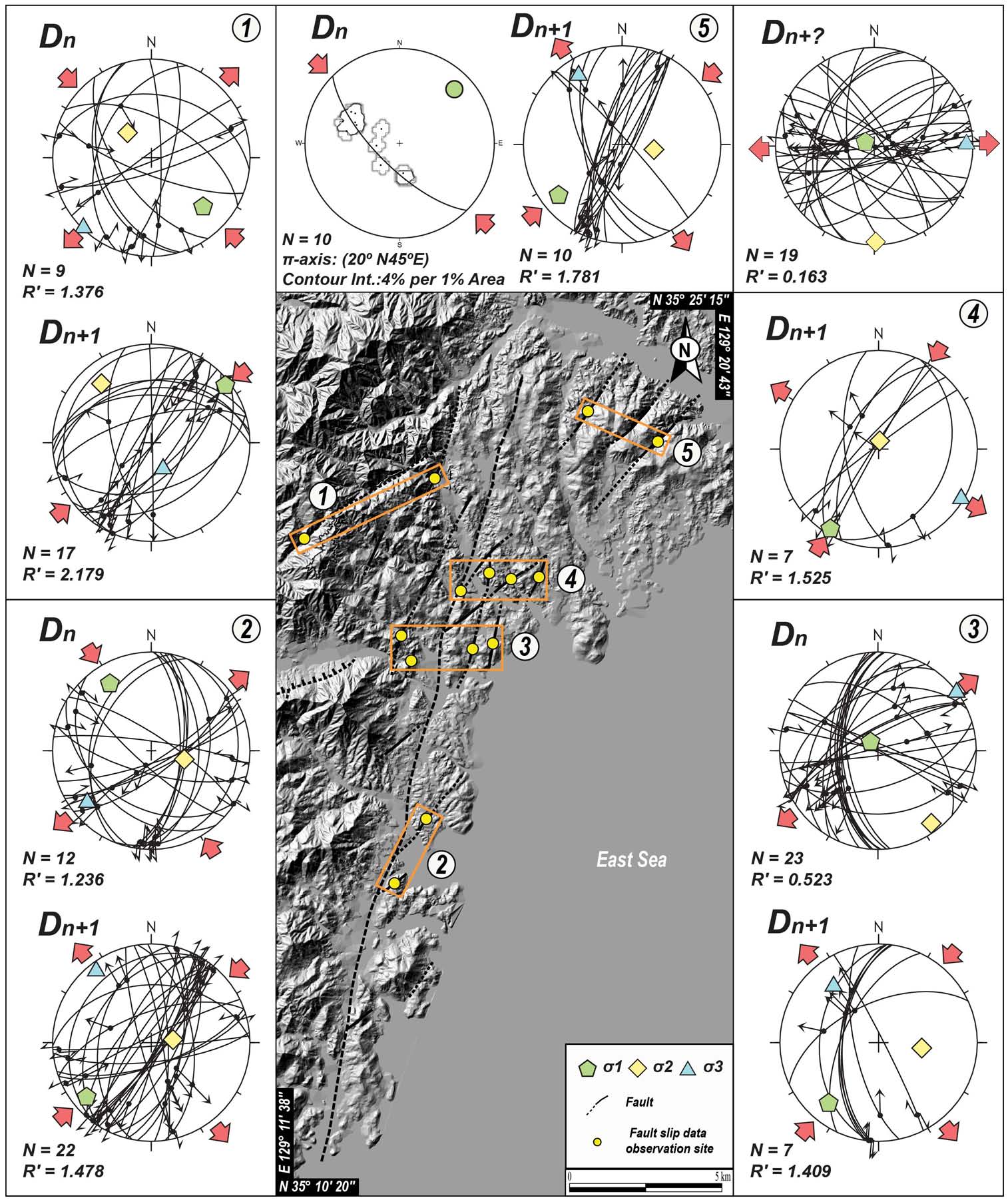
Slip data obtained from the faults and shear fractures and fold axis estimated from best-fitting π-circle of various attitudes of fold limbs in the study area (lower-hemisphere, equal-area projection). Convergent and divergent arrow heads represent horizontal contraction (σHmax) and stretching (σHmin) directions, respectively. Based on relative chronologies at outcrops, reconstructed paleostress regimes are roughly divided into (1) earlier NW-SE compression (or NE-SW tension) and (2) later NE-SW compression (or NW-SE tension). R’=R (σ1 is vertical), R’=2-R (σ2 is vertical), and R’=2+R (σ3 is vertical) [Choi (1995), Delvaux et al. (1997); R=(σ2-σ3)/(σ1-σ3)].
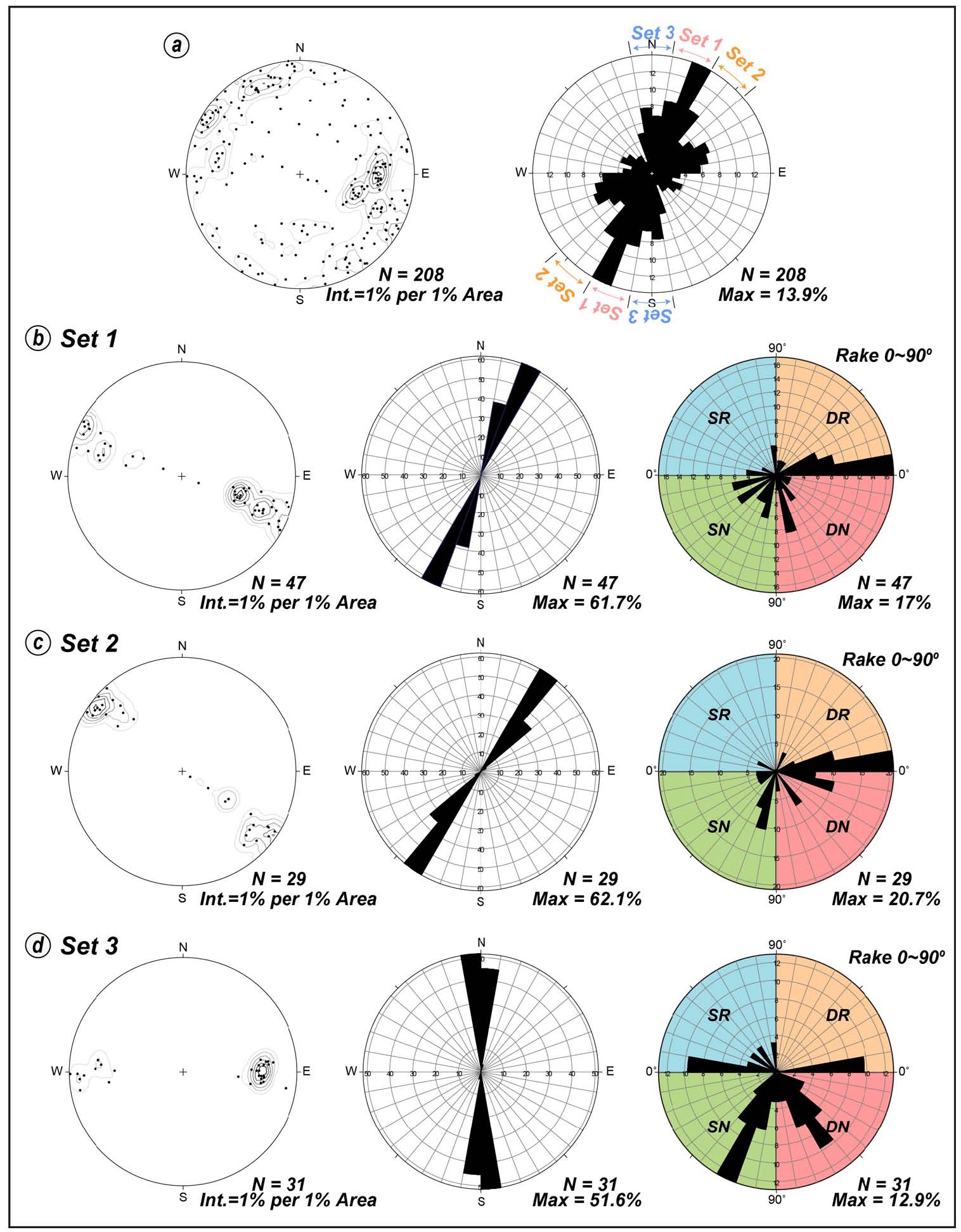
Attitudes of all the faults and shear fractures observed in the study area and their kinematics. (a) Rose diagram showing three groups of the faults and shear fractures, based on their strikes. (b) Set 1: NNE-striking faults. (c) Set 2: NE-striking faults. (d) Set 3: N-S-striking faults. See text for detailed explanation.
일광단층과 평행 또는 아평행한 중·소규모의 단층과 전단단열을 북북동, 북동 그리고 남-북 주향으로 나누어 방향성에 따른 야외 운동감각을 살펴보았다(그림 12). 일광단층의 주 운동을 주향이동으로 가정할 때, Y-전단에 해당하는 북북동 단층과 전단단열(Set 1)이 연구지역에서 가장 흔히 관찰된다. 이들은 미약한 역이동을 포함하는 우수향 주향이동 운동감각이 가장 우세하며, 다음으로 횡인장성 좌수향과 우수향 사교이동 운동감각이 함께 관찰된다(그림 12b). 북북동 Y-전단이 우수향일 때 R-전단으로 해석되는 북동 방향 단층과 전단단열(Set 2)은 Y-전단과 유사하게 미약한 역이동을 포함하는 우수향 주향이동 운동감각이 가장 우세하며, 다음으로 횡인장성 좌수향과 우수향 사교이동 운동감각이 관찰된다(그림 12c). 한편, 남-북 방향의 단층과 전단단열(Set 3)은 Y-전단이 우수향인 경우 P-전단 그리고 좌수향인 경우 R-전단으로 해석되는데, 횡인장성 좌수향 운동감각이 가장 우세하며 다음으로 횡인장성 우수향 사교이동과 거의 순수한 우수향과 좌수향 주향이동 운동감각이 모두 비슷한 빈도로 관찰된다(그림 12d).
이상과 같이 거의 동일한 주향의 단층과 전단단열에서 다양한 운동감각이 함께 관찰된다는 사실은 한 번의 지각변형 사건에 의한 결과로 설명될 수 없으며, 연구지역이 서로 다른 응력장 하에서 다중변형을 겪었음을 시사한다. 또한 북북동과 북동 방향의 단층과 전단단열들에서 우수향 주향이동 운동감각이 가장 뚜렷이 관찰된다는 점은 일광단층을 포함한 연구지역 북북동 단층들이 우수향 주향이동에 의해 가장 압도적으로 변형되었거나 우수향 주향이동이 좌수향에 비해 후기일 가능성을 암시해준다.
4.2 선택적 재활성
대륙지각 천부에서 누적된 응력이 해소될 때 새로운 단층이 형성되기보다는 기존의 약대가 재활할 가능성이 높다(Mckenzie, 1972; Sykes, 1978). 이러한 단층의 재활은 지진 활동뿐만 아니라 지각의 융기와 분지 침강에도 직접 관여하기 때문에 지질학의 중요한 연구주제가 되고 있다(Sibson, 1985; Cooper and Williams, 1989; Richard and Krantz, 1991; Pinheiro and Holdsworth, 1997; Kim et al., 2001; Avouac et al., 2014). 우리나라에서 가장 대표적 주향이동단층 중 하나인 양산단층 또한 다양한 연구를 통해 여러번의 재활을 겪었음이 보고되었으며(Chang et al., 1990; Kim, 1992; Chang and Chang, 1998; Chang, 2002; Hwang et al., 2004, 2007a, 2007b, 2008a, 2008b, 2012; Cho et al., 2007; Choi et al., 2009; Kang and Ryoo, 2009), 이번 연구결과에서도 일광단층 일원이 다중변형을 겪었음이 드러나고 있다.
이번 연구에서 제시된 단층암의 대자율이방성 결과 그리고 단층과 전단단열을 이용한 고응력장 복원과 방향성에 따른 운동감각은 양산단층계 동편에 위치한 일광단층 일원이 북북동 내지 북동 방향 단층들의 우수향 주향이동 단층운동에 의한 변형을 가장 압도적으로 겪었지만, 좌수향 감각의 운동 또한 겪었음을 명확히 보여주고 있다. 주목할 점은 단층암의 대자율이방성 측정결과(그림 10)와 야외에서 확인된 운동감각들은 연구지역 북동부에 발달하는 북동 방향의 단층들 중에서 2조는 좌수향 주향이동감각을 지시하는 반면, 1조는 우수향 주향이동감각을 지시한다는 것이다. 이러한 결과는 거의 동일한 방향을 가지는 단층들임에도 불구하고 응력환경의 변화에 따라 선택적으로 재활(selective reactivation)되었을 가능성을 제시한다. 단층의 재활 여부는 유효응력, 마찰계수, 유체의 점성, 주응력 축과 단열 사이의 각도, 단열의 경사각, 충전 물질 등에 의해 결정된다(e.g., Sibson, 1985, 1995; Kelly et al., 1999; Fossen, 2010; Bonini et al., 2012). 따라서 같은 방향을 가지는 약대들이 동일한 응력 하에 놓여있다 하더라도 다양한 요인들에 의해 재활 가능성이 달라질 수 있을 것이다. 이러한 단층의 안정성과 관련된 역학적인 특성을 보다 명확히 이해하기 위해서는 다양한 실내외의 다른 정량적인 연구가 추가적으로 요구된다.
4.3 일광단층의 운동사
양산단층계 단층들 중 가장 동편에 위치한 일광 단층의 운동사는 양산단층과 같은 다른 북북동 방향 단층들의 운동사와 밀접한 관련을 가질 것이다. Cho et al. (2007)은 양산단층과 동래단층 사이에 분포하는 화강암류(60~70 Ma)에 대한 대자율이방성 연구를 통해 북동 방향의 자기엽리구조가 양산단층의 좌수향 주향이동에 수반된 북서-남동 방향의 압축력에 의한 결과로 해석한 바 있다. 또한 Cho et al. (2008, 2011)은 양산단층과 동래단층 사이에서 확장된 다대포분지의 구조적인 특징(북서 방향의 쇄설성과 마그마 암맥, 북북동~북동 방향의 지층경동, 북서 방향의 퇴적동시성 단층)과 기반암과 분지충전물의 절대 연령 결과를 토대로, 다대포분지가 백악기 말(94~69 Ma 사이)에 두 단층의 좌수향 주향이동 운동에 의해 형성된 당겨열림분지임을 보고하였다. 이러한 연구결과들은 이번 연구에서 확인된 일광단층의 좌수향 주향이동의 시기가 양산과 동래단층이 좌수향 주향이동단층으로 운동한 백악기말에서 고신생기 초에 해당될 가능성이 높음을 시사한다.
한편 양산단층의 우수향 주향이동운동은 양산단층계의 진화사에 있어 가장 주요한 운동으로 평가되는데, 양산단층을 따라 암상의 분포에서 확연히 나타나는 우수향의 수평변위 뿐만 아니라 노두에서 확인되는 다양한 변형구조들은 우수향 주향이동이 매우 압도적이었음을 알려주고 있다(Chang et al., 1990; Kim, 1992; Chang and Chang, 1998; Chang, 2002; Choi et al., 2009). 양산단층에 의해 우수향으로 절단된 가장 젊은 암석은 포항시 기계면 그리고 경주시 배동과 남산동에 분리(separation)되어 분포하는 A-형 알칼리장석화강암(남산화강암)으로 약 21.3 km의 우수향 수평변위가 인지된다(Hwang et al., 2004, 2007). 이 화강암의 절대연령은 다양한 연대측정방법에 근거하여 50~46.5 Ma로 보고되었으며(Lee et al., 1997; Koh, 2001; Hwang et al., 2004, 2007), 이는 양산단층의 우수향 주향이동이 50 Ma 이후에 발생하였음을 지시한다. 한편, 한반도 남동부에 광역적으로 분포하고 있는 남-북 내지 북북동 방향 염기성~중성 암맥군의 Ar-Ar 절대연령측정 결과는 51~44 Ma로, 당시에 한반도 일원에 광역적인 동-서 방향의 인장응력이 작동하였음을 지시한다(Kim et al., 2005; Son et al., 2007). 이번 연구에서 일광단층 일원 역시 양산단층과 동일하게 우수향 운동감각이 가장 우세하게 인지되며 가장 젊은 암석으로 판단되는 중성 암맥들(~44 Ma)이 우수향 주향이동 단층에 의해 절단되어 있음이 관찰되었다(그림 5a). 또한 염기성 내지 중성 암맥이 우수향 주향이동단층에 의해 절단되는 양상은 양산과 동래단층에 수반되는 법기단층을 따라서도 확인된 바 있다(Son et al., 2003). 이러한 직·간접인 증거들을 근거할 때, 양산단층계의 우수향 주향이동운동을 주도한 북동-남서 방향의 압축응력은 44 Ma 이후에도 지속되었을 것이다.
한편, 일광단층을 포함하는 양산단층계는 우수향 주향이동 이후에도 지구조 환경 변화에 따른 응력장의 변화로 또 다른 운동감각으로 재활되었을 가능성이 높다. 그러나 현재 여러 단층들을 따라 나타나는 뚜렷한 우수향 주향이동 증거들은 후기 응력에 의해 양산단층계의 일부 분절들이 새로운 운동감각으로 재활되었다 하더라도 이들 단층의 우수향 주향이동 기록들의 대부분을 지울만한 광역적이고 압도적인 단층운동은 발생하지 않았음을 지시해준다.
5. 결 론
상세한 야외조사를 통해 양산단층계의 가장 동편에 위치하는 일광단층 일원 부차단층들의 분포, 기하 그리고 운동학적 특성을 기재하고 분석하여 일광단층 일원의 구조 운동사를 규명하고자 하였다. 이번 연구를 통해 얻어진 주요 결론은 다음과 같다.
- 1) 일광단층 일원은 주향이동단층대에서 일반적으로 보고되는 R-, Y- 그리고 P-shear에 해당되는 다양한 규모의 부차단층들이 남-북, 북북동, 북동 방향으로 발달하며, 경상분지의 퇴적암류, 화산암류 그리고 심성암류를 절단하고 있다. 이들은 응집력이 없는 단층비지 또는 단층각력으로 구성된 ~1.5 m 두께의 단층핵과 수십 m 이내의 단층손상대로 나타나며, 단층대 내에 망상으로 발달하는 광맥들은 연구지역이 단층활동 당시 또는 이후에 상당한 열수작용을 겪었음을 지시한다.
- 2) 야외에서 확인되는 구조들의 상대적인 선후관계와 중·소규모 단층과 전단단열의 기하 및 운동감각은 연구지역이 다중변형을 겪었음을 지시하며, 특히 주요 부차단층들이 백악기말~고신생기초의 북서-남동 압축 환경 하에서 좌수향 주향이동운동을 겪었으며, 빠르면 50 Ma 이후에 북동-남서 압축 환경 하에서 우수향 주향이동운동을 겪은 것으로 판단된다.
- 3) 연구지역 북동부에 발달하는 북동 방향의 단층들에 대한 대자율이방성 분석 결과는 야외에서 관찰된 단층의 운동감각과 잘 부합된다. 북동방향의 유사한 주향을 가지는 단층들임에도 불구하고 단층에 따라 우수향과 좌수향의 서로 다른 이동감각을 보이고 있어, 응력환경의 변화에 따라 단층의 선택적 재활이 발생한 것으로 판단된다.
- 4) 이번 연구를 통해 해석된 일광단층 일원의 단층 운동사는 기존 연구에서 보고된 양산단층의 운동사와 유사하며, 이는 한반도 남동부 일원 양산단층계 단층들이 응력환경이 변화하는 동안 유사한 진화사를 겪었음을 의미한다.
Acknowledgments
이 논문은 2014년 정부(교육과학기술부)의 재원으로 한국연구재단의 지원을 받아 수행된 기초연구사업(2014R1A2A1A11053102)의 연구결과이다. 심사과정에서 유익한 조언을 주신 기원서 박사님과 익명의 심사위원, 편집위원장님께 감사드린다.
REFERENCES
-
Astudillo, N., Roperch, P., Townley, B., Attiagada, C., and Maksaev, V., (2008), Importance of small-block rotations in damage zones along transcurrent faults. Evidence from Chuquicamata open pit, Northern Chile, Tectonophysics, 450, p1-20.
[https://doi.org/10.1016/j.tecto.2007.12.008]

-
Avouac, J.P., Ayoub, F., Wei, S., Ampuero, J.P., Meng, L., Leprince, S., Jolivet, R., Duputel, Z., and Helmberger, D., (2014), The 2013, Mw 7.7 Balochistan earthquake, energetic strike-slip reactivation of a thrust fault, Earth and Planetary Science Letters, 391, p128-134.
[https://doi.org/10.1016/j.epsl.2014.01.036]

- Balsley, J.R., and Buddington, A.F., (1960), Magnetic susceptibility anisotropy and fabric of some Adirondack granites and ortho-gneisses, American Journal of Science, 258-A, p6-20.
-
Bonini, M., Sani, F., and Antonielli, B., (2012), Basin inversion and contractional reactivation of inherited normal faults: A review based on previous and new experimental models, Tectonophysics, 522, p55-88.
[https://doi.org/10.1016/j.tecto.2011.11.014]

-
Caine, J.S., Evans, J.P., and Forster, C.B., (1996), Fault zone architecture and permeability structure, Geology, 24, p1125-1128.
[https://doi.org/10.1130/0091-7613(1996)024<1025:FZAAPS>2.3.CO;2]

- Chang, C.-J., (2002), Structural characteristics and evolution of the Yangsan fault, SE Korea, Ph.D. Thesis, Kyungpook National University, Daegu, p259, (in Korean with English abstract).
- Chang, C.-J., and Chang, T.W., (1998), Movement History of the Yangsan Fault based on Paleostress Analysis, The Journal of Engineering Geology, 8, p35-49, (in Korean with English abstract).
- Chang, C.-J., and Chang, T.W., (2009), Behavioral Characteristics of the Yangsan Fault based on Geometric Analysis of Fault Slip, Journal of Engineering Geology, 19, p277-285, (in Korean with English abstract).
- Chang, K.H., Woo, B.G., Lee, J.H., Park, S.O., and Yao, A., (1990), Cretaceous and Early Cenozoic stratigraphy and history of eastern Kyongsang Basin, S. Korea, Journal of the Geological Society of Korea, 26, p471-487, (in Korean with English abstract).
-
Chester, F.M., Evans, J.P., and Biegel, R.L., (1993), Internal structure and weakening mechanisms of the San Andreas Fault, Journal of Geophysical Research, 98, p771-786.
[https://doi.org/10.1029/92JB01866]

- Cho, H., Kim, J.-S., Son, M., Sohn, Y.K., and Kim, I.-S., (2011), Petrography and 40Ar/39Ar ages of volcanic rocks in the Cretaceous Dadaepo Basin, Busan: Accumulation time and correlation of the Dadaepo Formation, Journal of the Geological Society of Korea, 47, p1-18, (in Korean with English abstract).
-
Cho, H., Kim, M.-C., Kim, H., and Son, M., (2014), Anisotropy of Magnetic Susceptibility (AMS) of the Quaternary Faults, SE Korea: Application to the Determination of Fault Slip Sense and Paleo-stress Field, Journal of the Petrological Society of Korea, 23, p75-103, (in Korean with English abstract).
[https://doi.org/10.7854/JPSK.2014.23.2.75]

- Cho, H., Son, M., and Kim, I.-S., (2007), Anisotropy of magnetic susceptibility (AMS) of the granitic rocks in the Eastern Region of the Yangsan Fault, Economic and Environmental Geology, 40, p171-189, (in Korean with English abstract).
- Cho, H., Son, M., Song, C., and Kim, I., (2008), Geological structures of the late Cretaceous Dadaepo basin, SE Korea, and their tectonic implication, American Geophysical Union, Fall Meeting 2008 (abstract), San Francisco, December 15-19, T53D-2002.
- Choi, H.I., Oh, J.H., Shin, S.C., and Yang, M.Y., (1980), Geology and geochemistry of the Gyeongsang strata in Ulsan area, Korea Institute of Energy and Resources Bulletin, 20, p33, (in Korean with English abstract).
- Choi, J.-H., Yang, S.-J., and Kim, Y.-S., (2009), Fault zone classification and structural characteristics of the southern Yangsan fault in the Sangcheon-ri area, SE Korea, Journal of the Geological Society of Korea, 45, p9-28, (in Korean with English abstract).
- Choi, P.Y., (1995), Aspects of stress inversion methods in fault tectonic analysis, Annales Tectonicae, 9, p22-38.
- Chwae, U.C., Hwang, J.H., Yoon, W., and Kim, D.H., (1988), Explanatory Note of The Eoil Sheets, 1:25,000, Korea Institute of Geoscience and Mineral Resources.
- Cooper, M.A., and Williams, G.D., (1989), Inversion Tectonics, Geological Society, London, Special Publication, 44, p356.
-
Cunningham, W.D., and Mann, P., (2007), Tectonics of strikeslip restraining and releasing bends, In: Cunningham, W.D., and Mann, P. (eds), Tectonics of Strike-Slip Restraining and Releasing Bends, Geological Society, London, Special Publication, 290, p1-12.
[https://doi.org/10.1144/SP290.1]

- Davis, G.H., and Reynolds, S.J., (1996), Structural geology of rocks and regions, (2nd edition), John Wiley and Sons, Danvers, p776.
-
Delvaux, D., Moeys, R., Stapel, G., Petit, C., Live, K., Miroshnichenko, A., Ruzhich, V., and San’kov, V., (1997), Paleostress reconstructions and geodynamics of the Baikal region, Central Asia, Part2. Cenozoic rifing, Tectonophysics, 282, p1-38.
[https://doi.org/10.1016/S0040-1951(97)00210-2]

-
Fossen, H., (2010), Structural Geology, Cambridge University Press, Cambridge, p463.
[https://doi.org/10.1017/CBO9780511777806]

-
Hrouda, F., (1982), Magnetic anisotropy of rocks and its application in geology and geophysics, Geophysical Surveys, 5, p37-82.
[https://doi.org/10.1007/BF01450244]

-
Hwang, B.H., Ernst, W.G., McWilliams, M., and Yang, K., (2008a), Geometric model of conjugate faulting in the Gyeongsang Basin, southeast Korea, Tectonics, 27, TC6015 p15.
[https://doi.org/10.1029/2008TC002343]

- Hwang, B.H., Lee, J.D., and Yang, K., (2004), Petrological study of the granitic rocks around the Yangsan fault: Lateral displacement of the Yangsan fault, Journal of the Geological Society of Korea, 40, p161-178, (in Korean with English abstract).
-
Hwang, B.H., Lee, J.D., Yang, K., and McWilliams, M., (2007a), Cenozoic strike-slip displacement along the Yangsan fault, southeast Korean Peninsula, International Geology Review, 49, p768-775.
[https://doi.org/10.2747/0020-6814.49.8.768]

-
Hwang, B.H., McWilliams, M., Son, M., and Yang, K., (2007b), Tectonic implication of A-type granites across the Yangsan fault, Gigye and Gyeongju areas, southeast Korean Peninsula, International Geology Review, 49, p1094-1102.
[https://doi.org/10.2747/0020-6814.49.12.1094]

-
Hwang, B.H., Son, M., Yang, K., Yoon, J., and Ernst, W.G., (2008b), Tectonic evolution of the Gyeongsang Basin, southeastern Korea from 140 Ma to the present, based on a strike-slip and block-rotation tectonic model, International Geology Review, 50, p343-363.
[https://doi.org/10.2747/0020-6814.50.4.343]

-
Hwang, B.H., Son, M., Kim, J.-S., Yang, K., and Kim, J.-S., (2012), Cenozoic wrench tectonics and oroclinal bending in SE Korea, International Geology Review, 54, p642-653.
[https://doi.org/10.1080/00206814.2011.562389]

-
Jelínek, V., (1981), Characterization of the magnetic fabric of rocks, Tectonophysics, 79, p63-67.
[https://doi.org/10.1016/0040-1951(81)90110-4]

- Kang, H.-C., (2014), Geological investigation report of Gijang Research reactor, Nexgeo, p342, (in Korean).
- Kang, J.-H., and Ryoo, C.-R., (2009), The movement history of the southern part of the Yangsan Fault Zone interpreted from the geometric and kinematic characteristics of the Sinheung Fault, Eonyang, Gyeongsang Basin, Korea, Journal of the Petrological Society of Korea, 18, p19-30, (in Korean with English abstract).
-
Kelly, P.G., Peacock, D.C.P., Sanderson, D.J., and McGurk, A.C., (1999), Selective reverse-reactivation of normal faults, and deformation around reverse-reactivated faults in the Mesozoic of the Somerset coast, Journal of Structural Geology, 21, p493-509.
[https://doi.org/10.1016/S0191-8141(99)00041-3]

- Kim, D.H., Hwang, J.H., Park, G.H., and Song, G.Y., (1998), Explanatory text of the geological map of Pusan sheet, 1:250,000, Korea research Institute of Geoscience and Mineral Resources, p62.
-
Kim, H.-J., Baek, Y.S., Jou, H.-T., Lee, S.H., Moon, S., Kim, J.S., Lee, S., Lee, G.H., Kang, S.-G., Son, W.-H., and Seok, R., (2015), Seismic reflection imaging of Quaternary faulting offshore the southeastern Korean Peninsula, Geosciences Journal, (in press).
[https://doi.org/10.1007/s12303-015-0055-9]

- Kim, I.-S., (1992), Origin and tectonic evolution of the East Sea (Sea of Japan) and the Yangsan fault system: a new synthetic interpretation, Journal of the Geological Society of Korea, 28, p84-109, (in Korean with English abstract).
- Kim, J.-S., Ree, J.-H., Han, S.-H., Kim, H.-S., Lee, Y.-J., Lee, K.-J., and Joo, B.-C., (2003), The Ilkwang Fault in southeastern Korea revealed by geophysical and trench surveys, Journal of the Geological Society of Korea, 39, p211-223, (in Korean with English abstract).
- Kim, J.-S., Son, M., Kim, J.-S., and Kim, J., (2005), 40Ar/39Ar ages of the Tertiary dike swarm and volcanic rocks, SE Korea, Journal of the Petrological Society of Korea, 14, p93-107, (in Korean with English abstract).
- Kim, N.J., Kwon, Y.I., and Jin, M.S., (1971), 1:50,000 Explanatory Text of the Geological Map of Moryang Sheet, 1:50,000, Geological Survey of Korea, p19, (in Korean with English abstract).
-
Kim, Y.-S., Andrews, J.R., and Sanderson, D.J., (2001), Reactivated strike-slip faults: examples from north Cornwall, UK, Tectonophysics, 340, p173-194.
[https://doi.org/10.1016/S0040-1951(01)00146-9]

-
Kim, Y.-S., Peacock, D.C.P., and Sanderson, D.J., (2004b), Fault damage zones, Journal of Structural Geology, 26, p503-517.
[https://doi.org/10.1016/j.jsg.2003.08.002]

- Koh, J.S., (2001), Mineralogical, geochemical and Sr-Nd isotopic characteristics of the Namsan A-type and Gyeongju I-type granitic rocks in the Gyeongsang basin, Korea, Unpubl. Ph.D. thesis, Pusan National University, p173, (in Korean with English abstract).
- Korea Hydro & Nuclear Power Co. Ltd, (2002), Preliminary Safety Analysis Report of Shin KORI Units 3,4, p133, (in Korean).
- Lee, H.-K., and Yang, J.-S., (2005), ESR dating of the Ilkwang fault, Journal of the Geological Society of Korea, 41, p369-384, (in Korean with English abstract).
- Lee, J.I., Lee, M.J., Doo, K.T., Lee, M.S., and Nagao, K., (1997), K-Ar age determination of the granitic plutons in Ulsan-Kyeongju area, the mid-eastern Kyeongsang Basin, Korea, Journal of the Korean Earth Science Society, 18, p379-386, (in Korean with English abstract).
- Lee, M.S., and Kang, P.C., (1964), Explanatory Text of the Geological Map of Yangsan Sheet, 1:50,000, Geological Survey of Korea, p27.
- Lee, Y.J., and Lee, I.K., (1972), Explanatory Text of the Geological Map of Eonyang Sheet, 1:50,000, Geological Survey of Korea, p22.
-
McKenzie, D.P., (1972), Active tectonics of the Mediterranean region, Geophysical Journal International, 30, p109-185.
[https://doi.org/10.1111/j.1365-246X.1972.tb02351.x]

- Park, Y.D., and Yoon, H.D., (1968), Explanatory text of the geological map of Bangeujin sheet, 1:50,000, Geological survey of Korea, p27.
-
Pinheiro, R.V.L., and Holdsworth, R.E., (1997), Reactivation of Archaean strike-slip fault systems, Amazon region, Brazil, Journal of the Geological Society, 154, p99-103.
[https://doi.org/10.1144/gsjgs.154.1.0099]

- Reedman, A.J., and Um, S.H., (1975), The geology of Korea: Seoul, Korea, Geological and Mining Institute of Korea, p139.
-
Richard, P., and Krantz, R.W., (1991), Experiments on fault reactivation in strike-slip mode, Tectonophysics, 188, p117-131.
[https://doi.org/10.1016/0040-1951(91)90318-M]

-
Rochette, P., Jackson, M., and Aubourg, C., (1992), Rock magnetism and the interpretation of anisotropy of magnetic susceptibility, Review of Geophysics, 30, p209-226.
[https://doi.org/10.1029/92RG00733]

-
Sibson, R.H., (1985), A note on fault reactivation, Journal of Structural Geology, 7, p751-754.
[https://doi.org/10.1016/0191-8141(85)90150-6]

-
Sibson, R.H., (1995), Selective fault reactivation during basin inversion: potential for fluid redistribution through fault-valve action, Geological Society Special Publication, 88, p3-19.
[https://doi.org/10.1144/GSL.SP.1995.088.01.02]

-
Solum, J.G., and van der Pluijm, B.A., (2009), Quantification of fabrics in clay gouge from the Carboneras fault, Spain and implications for fault behavior, Tectonophysics, 475, p554-562.
[https://doi.org/10.1016/j.tecto.2009.07.006]

- Son, C.M., Lee, S.M., Kim, Y.K., Kim, S.W., and Kim, H.S., (1978), Explanatory text of the geological map of Dongrae and Weolnae sheet, 1:50,000, Korea research Institute of Geoscience and Mineral Resources, p27.
- Son, M., Kim, J.-S., Hwang, B.-H., Lee, I.-H., Kim, J., Song, C.W., and Kim, I.-S., (2007), Paleogene dyke swarms in the eastern Geoje Island, Korea: their absolute ages and tectonic implications, Journal of the Petrological Society of Korea, 16, p82-99, (in Korean with English abstract).
- Son, M., Kim, J.S., Hwang, B.-H., Ryoo, C.-R., Ock, S.-S., Hamm, S.-Y., and Kim, I.-S., (2003), Geology and fracture distribution in the vicinities of the Cheonseong and Jeongjok mountains, Journal of Engineering Geology, 13, p107-127, (in Korean with English abstract).
-
Stacey, F.D., Joplin, G., and Lindsay, J., (1960), Magnetic anisotropy and fabric of some foliated rocks from S.E. Australia, Geofisica Pura Applicata, 47, p30-40.
[https://doi.org/10.1007/BF01992481]

-
Sykes, L.R., (1978), Intraplate seismicity, reactivation of preexisting zones of weakness, alkaline magmatism, and other tectonism postdating continental fragmentation, Reviews of Geophysics, 16, p621-687.
[https://doi.org/10.1029/RG016i004p00621]

-
Sylverster, A.G., (1988), Strike-slip faults, Bulletin of the Geological Society of America, 100, p1666-1703.
[https://doi.org/10.1130/0016-7606(1988)100<1666:SSF>2.3.CO;2]

-
Townend, J., and Zoback, M.D., (2000), How faulting keeps the crust strong, Geology, 28, p399-402.
[https://doi.org/10.1130/0091-7613(2000)28<399:HFKTCS>2.0.CO;2]

- Twiss, R.J., and Moores, E.M., (2007), Structural geology, Freeman, New York, p231-265.
- Um, S.H., Choi, H.I., Son, J.D., Oh, J.H., Shin, S.C., and Yun, H.S., (1983), Geology and geochemical study of Gyeongsang super group in the Gyeongsang Basin, Korea Institute of Geology, Mining, and Minerals (KIGAM), Research Report, no. 36, p118, (in Korean with English abstract).
- Wilcox, R.E., (1973), Basic Wrench Tectonics, Bulletin of the American Association of Petroleum Geologists, 57, p74-96.

